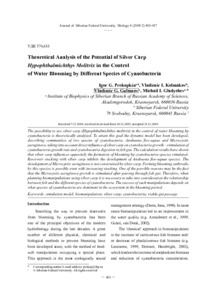Теоретический анализ потенциала толстолобика Hypophthalmichthys molitrix для контроля цветения воды, вызываемого разными видами цианобактерий
Скачать файл:
URI (для ссылок/цитирований):
https://elib.sfu-kras.ru/handle/2311/1627Автор:
Прокопкин, И.Г.
Prokopkin, Igor G.
Колмаков, В.И.
Kolmakov, Vladimir I.
Губанов, В.Г.
Gubanov, Vladimir G.
Гладышев, М.И.
Gladyshev, Michail I.
Дата:
2009-12Аннотация:
В работе проводится теоретический анализ возможности белого толстолобика
(Hypophthalmichthys molitrix) контролировать «цветение» водоемов некоторыми видами
цианобактерий. Для решения этой задачи построена имитационная модель, описывающая
сообщество цианобактерий в абстрактном водоеме. В качестве моделируемых видов выбраны
Anabaena flos-aquae и Microcystis aeruginosa. Модельные расчеты показывают, что интродукция
рыб в водоем подавляет развитие Anabaena flos-aquae. «Цветение» воды, формируемое
Microcystis aeruginosa, наоборот не сдерживается белым толстолобиком. Одной из причин
такой реакции Microcystis aeruginosa на зарыбление водоема белым толстолобиком может
быть стимуляция роста этого вида после прохождения через кишечник рыб.Таким образом,
возможность белого толстолобика контролировать рост цианобактерий в масштабах
целого водоема носит видоспецифичный характер, который необходимо учитывать при
планировании мероприятий по ликвидации «цветений». The possibility to use silver carp (Hypophthalmichthys molitrix) in the control of water blooming by
cyanobacteria is theoretically analyzed. To attain this goal the dynamic model has been developed,
describing communities of two species of cyanobacteria: Anabaena flos-aquae and Microcystis
aeruginosa, taking into account direct influence of silver carp on cyanobacteria growth - stimulation of
cyanobacteria growth rate and cyanobacteria digestion in fish gut. The calculation results have shown
that silver carp influences oppositely the formation of blooming by cyanobacteria species simulated.
Reservoir stocking with silver carp inhibits the development of Anabaena flos-aquae species. The
development of Microcystis aeruginosa is not constrained by silver carp. Forming blooming outbreaks
by this species is possible even with increasing stocking. One of the possible reasons may be the fact
that the Microcystis aeruginosa growth is stimulated after passing through fish gut. Therefore, when
planning biomanipulations using silver carp it is necessary to take into consideration the relationship
between fish and the different species of cyanobacteria. The success of such manipulations depends on
what species of cyanobacteria are dominant in the ecosystem in the blooming period.

